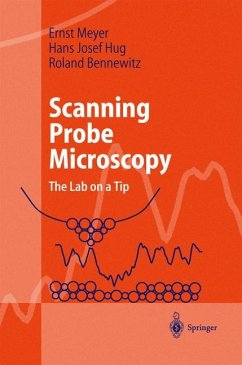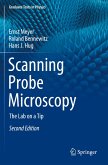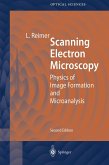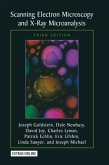Written by three leading experts in the field, this textbook describes and explains all aspects of the scanning probe microscopy. Emphasis is placed on the experimental design and procedures required to optimize the performance of the various methods. Scanning Probe Microscopy covers not only the physical principles behind scanning probe microscopy but also questions of instrumental designs, basic features of the different imaging modes, and recurring artifacts. The intention is to provide a general textbook for all types of classes that address scanning probe microscopy. Third year undergraduates and beyond should be able to use it for self-study or as textbook to accompany a course on probe microscopy. Furthermore, it will be valuable as reference book in any scanning probe microscopy laboratory. Novel applications and the latest important results are also presented, and the book closes with a look at the future prospects of scanning probe microscopy, also discussing related techniques in nanoscience. Ideally suited as an introduction for graduate students, the book will also serve as a valuable reference for practising researchers developing and using scanning probe techniques.
Two decades after its invention, scanning probe microscopy has become a widely used method in laboratories as diverse as industrial magnetic stor age development or structural biology. Consequently, the community of users ranges from biologists and medical researchers to physicists and engineers, all of them exploiting the unrivalled resolution and profiting from the relative simplicity of the experimental implementation. In recent years the authors have taught numerous courses on scanning probe microscopy, normally in combination with hands-on student experi ments. The audiences ranged from physics freshmen to biology post-docs and even high-school teachers. We found it of particular importance to cover not only the physical principles behind scanning probe microscopy but also ques tions of instrumental designs, basic features of the different imaging modes, and recurring artifacts. With this book our intention is to provide a gen eral textbook for all types of classes that address scanning probe microscopy. Third year undergraduates and beyond should be able to use it for self-study or as textbook to accompany a course on probe microscopy. Furthermore, it will be valuable as reference book in any scanning probe microscopy labora tory.
Two decades after its invention, scanning probe microscopy has become a widely used method in laboratories as diverse as industrial magnetic stor age development or structural biology. Consequently, the community of users ranges from biologists and medical researchers to physicists and engineers, all of them exploiting the unrivalled resolution and profiting from the relative simplicity of the experimental implementation. In recent years the authors have taught numerous courses on scanning probe microscopy, normally in combination with hands-on student experi ments. The audiences ranged from physics freshmen to biology post-docs and even high-school teachers. We found it of particular importance to cover not only the physical principles behind scanning probe microscopy but also ques tions of instrumental designs, basic features of the different imaging modes, and recurring artifacts. With this book our intention is to provide a gen eral textbook for all types of classes that address scanning probe microscopy. Third year undergraduates and beyond should be able to use it for self-study or as textbook to accompany a course on probe microscopy. Furthermore, it will be valuable as reference book in any scanning probe microscopy labora tory.
From the reviews:
"This book provides a nice and clearly written introduction to scanning probe microscopy (SPM) ... . It addresses a large audience that ranges from high school teachers to undergraduates to graduate students and post-docs in physics and biology." (opn - Optics & Photonics News, Vol. 16 (9), 2005)
"In this book, the authors aim to give a general introduction to SPM and highlight some of the many applications of this technique. ... the book succeeds in conveying the wide range of SPM techniques and their applications in an enthusiastic manner. ... it is well referenced and will serve as a good starting point for further studies. However, it will be of most use to researchers and students with a particular interest in SFM and MFM." (Steven R Schofield, The Physicist, Vol. 41 (3), May/June, 2004)
"The book is well written and well laid out, providing a good, logical progression from one subject area to the next. Generally, a goodbalance between theory and experiment is struck, with an appropriate number of quite beautiful images. ... References are plentiful and appropriate ... . the book's sub-title The Lab on a Tip is entirely appropriate. I thoroughly recommend this book to anyone who is interested in applying any SPM technique ... . (Dr. M. Salt, Contemporary Physics, Vol. 45 (6), 2004)
"This book provides a nice and clearly written introduction to scanning probe microscopy (SPM) ... . It addresses a large audience that ranges from high school teachers to undergraduates to graduate students and post-docs in physics and biology." (opn - Optics & Photonics News, Vol. 16 (9), 2005)
"In this book, the authors aim to give a general introduction to SPM and highlight some of the many applications of this technique. ... the book succeeds in conveying the wide range of SPM techniques and their applications in an enthusiastic manner. ... it is well referenced and will serve as a good starting point for further studies. However, it will be of most use to researchers and students with a particular interest in SFM and MFM." (Steven R Schofield, The Physicist, Vol. 41 (3), May/June, 2004)
"The book is well written and well laid out, providing a good, logical progression from one subject area to the next. Generally, a goodbalance between theory and experiment is struck, with an appropriate number of quite beautiful images. ... References are plentiful and appropriate ... . the book's sub-title The Lab on a Tip is entirely appropriate. I thoroughly recommend this book to anyone who is interested in applying any SPM technique ... . (Dr. M. Salt, Contemporary Physics, Vol. 45 (6), 2004)








